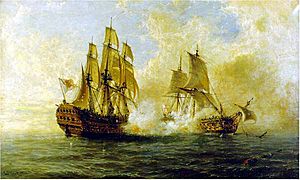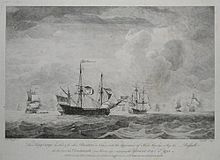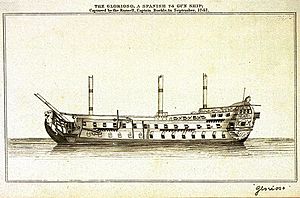Voyage of the Glorioso facts for kids
Quick facts for kids Battles of the Glorioso |
|||||||
|---|---|---|---|---|---|---|---|
| Part of the War of Jenkins' Ear | |||||||
 Combat of the Glorioso against HMS Dartmouth. Oil on canvas by Ángel Cortellini Sánchez, 1891. |
|||||||
|
|||||||
| Belligerents | |||||||
| Commanders and leaders | |||||||
| John Crookshanks John Hamilton † Robert Erskine George Walker Matthew Buckle |
Pedro Messia de la Cerda | ||||||
| Strength | |||||||
| 4 ships of the line, 7 frigates, 2 brigs |
70-gun ship of the line Glorioso |
||||||
| Casualties and losses | |||||||
| 1 ship of the line sunk 1 frigate sunk several ships damaged, 296-334 killed, several hundred wounded |
Glorioso captured, 33 killed, 130 wounded (last combat) |
||||||
The voyage of the Glorioso was a series of four exciting sea battles in 1747. These battles happened during the War of the Austrian Succession. They involved a brave Spanish warship called the Glorioso and several British navy groups. The Glorioso was a large ship with 70 cannons. It was carrying a huge treasure of four million silver dollars from the Spanish colonies in America.
The Glorioso managed to fight off two British attacks near the Azores and Cape Finisterre. It successfully delivered its valuable cargo to the port of Corcubión, Spain. After unloading the treasure, the Glorioso sailed for repairs. Near Cape St. Vincent, it was attacked again by British privateer ships and two large warships. One British ship, the Dartmouth, blew up during the fight. However, the 92-gun Russell eventually forced the Glorioso to surrender. The British took the Glorioso to Lisbon, where it was taken apart because it was too damaged. The Spanish commander, Pedro Messia de la Cerda, and his crew were captured. But they were seen as heroes in Spain and even earned respect from the British. Some British officers were put on trial by the navy for not fighting well against the Spanish ship.
Contents
The Amazing Battles of the Glorioso
First Battle: Fighting Near the Azores
In July 1747, the Spanish warship Glorioso was sailing back to Spain from America. It was carrying about four million silver dollars. On July 25, near the island of Flores in the Azores, the crew saw a British merchant convoy. It was hard to see because of the fog. When the fog cleared, Captain Pedro Messia de la Cerda saw ten British ships. Three of them were warships: the 60-gun Warwick, the 40-gun frigate Lark, and a smaller 20-gun brig.
Captain de la Cerda got his ship ready for battle. But he tried to avoid fighting to protect the valuable treasure. He kept his ship in a good position against the wind. The British ships started chasing the Glorioso. Around 9:00 p.m., the smaller British sloop caught up. There was some shooting, but it didn't do much damage. Then, a sudden strong wind hit at 2:00 p.m., which slowed the Glorioso. This allowed the other British ships to get closer.
John Crookshanks, the British convoy's leader, sent the brig to guard the merchant ships. He ordered HMS Lark to attack the Glorioso. The Spanish ship fired back with heavy cannons. The British frigate was badly damaged in its body and ropes. Then HMS Warwick arrived and started fighting the Glorioso. But the Warwick lost all its masts and had to leave the battle. The Glorioso was hit by four cannonballs in its body. Its ropes were also damaged. Five people died on the Glorioso, and 44 were hurt. Even with a lot of damage, HMS Warwick only had four sailors killed and 20 wounded.
When the British Navy leaders heard about this battle, Crookshanks was put on trial. He was found guilty of not helping enough and not fighting well. He was removed from the Navy, but he was allowed to keep his rank.
Second Battle: Near Cape Finisterre
After the first battle, the Glorioso kept sailing towards Spain. Some of the damage could be fixed at sea. But the bigger repairs needed a proper port. Even so, the Glorioso managed to fight off another attack. This happened near Cape Finisterre against three British ships from Admiral John Byng's fleet. These ships were the 50-gun HMS Oxford, the 24-gun frigate HMS Shoreham, and the 20-gun brig HMS Falcon.
After fighting for three hours, all three British ships were badly damaged. They had to leave the battle. Captain Callis of HMS Oxford was later put on trial by the navy. But unlike Commodore Crookshanks, he was found innocent. The Glorioso lost its front pole and had more people hurt. But the next day, August 16, it finally reached the port of Corcubión, Spain. There, it safely unloaded its valuable treasure.
Third and Fourth Battles: The Final Stand
In Corcubión, the crew of the Glorioso made the necessary repairs. This made the ship safe to sail again. Captain de la Cerda first planned to go to Ferrol. But strong winds damaged the Glorioso's ropes again. So, the ship had to change course and head for Cadiz. It sailed away from the Portuguese coast to avoid more British ships. However, on October 17, it met a group of four British privateer ships near Cape Saint Vincent. These ships were private vessels allowed to attack enemy ships. This group was called the 'Royal Family' because of their names: King George, Prince Frederick, Princess Amelia, and Duke. Together, they had 960 men and 120 cannons.
At 8 a.m., the King George, which was the commander's ship, got close to the Glorioso. The two ships exchanged fire. The British frigate lost its tallest mast and two cannons from the Glorioso's first burst of gunfire. The Spanish and British ships fought for three hours. Both took heavy damage, and the King George had to break away. The Glorioso kept sailing south, chased by the three privateer frigates. Later, two more warships joined the chase: the 50-gun HMS Dartmouth and the huge 92-gun HMS Russell. This added over 250 cannons and thousands of men to the British side.
The captain of the Dartmouth, John Hamilton, managed to get his ship right next to the Glorioso. After a fierce fight, the British ship caught fire in its gunpowder storage area. It blew up at 3:30 PM on October 8. Captain Hamilton and most of his crew died in the explosion. Only a lieutenant and 11 sailors survived. Some sources say 14 survived out of 300 crew members. A survivor said the Dartmouth was already badly damaged when a shot from the Glorioso hit the gunpowder room. This started a fire that caused the ship to explode. These survivors were rescued by lifeboats from the Prince Frederick.
The three privateer frigates joined the Russell the next evening. Together, they shot at the Glorioso from all sides. The Spanish ship fought from midnight until 9 AM. It was almost sinking, nearly all its masts were gone, and it had no ammunition left. With 33 men killed and 130 wounded, Captain don Pedro Messia de la Cerda saw that defending was impossible. He surrendered his ship. HMS Russell had 12 sailors killed and several wounded. Eight more men died on the King George.
What Happened After the Battles
After the battle, the British ships sailed to Lisbon, taking the damaged Glorioso with them. The Spanish warship was inspected. But it was not used by the British Navy and was instead taken apart. Commodore Walker, who led the four privateer frigates, was strongly told off by one of the 'Royal Family' ship owners. The owner was upset that Walker risked his ship against a stronger force. Walker disagreed, saying:
Had the treasure been aboard the Glorioso, as I expected, my dear sir, your compliment would have been far different. Or had we let her escape from us with the treasure aboard, what would you have said then?
Captain de la Cerda and his men were taken aboard the Prince Frederick and King George. They were brought to Great Britain and held in London. There, they became admired by the British people. De la Cerda was later promoted to a higher rank for his brave fighting. The surviving crew members received rewards when they returned to Spain. Many British sources say the defense of the Glorioso is one of the most important stories in Spanish naval history.
See also
 In Spanish: Carrera del Glorioso para niños
In Spanish: Carrera del Glorioso para niños




